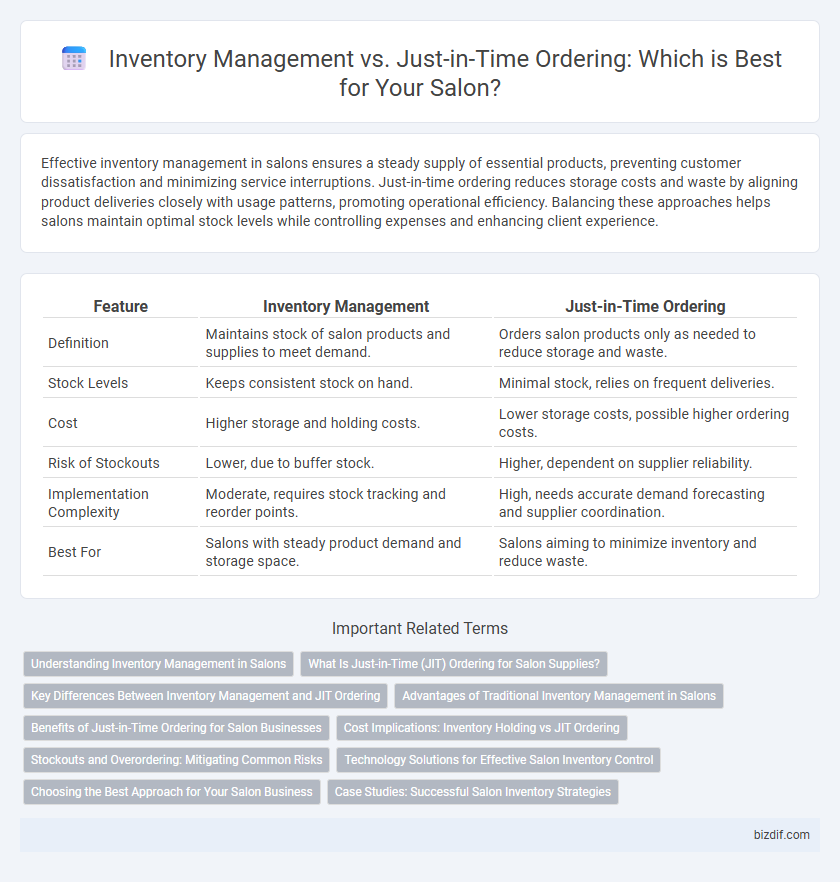Effective inventory management in salons ensures a steady supply of essential products, preventing customer dissatisfaction and minimizing service interruptions. Just-in-time ordering reduces storage costs and waste by aligning product deliveries closely with usage patterns, promoting operational efficiency. Balancing these approaches helps salons maintain optimal stock levels while controlling expenses and enhancing client experience.
Table of Comparison
| Feature | Inventory Management | Just-in-Time Ordering |
|---|---|---|
| Definition | Maintains stock of salon products and supplies to meet demand. | Orders salon products only as needed to reduce storage and waste. |
| Stock Levels | Keeps consistent stock on hand. | Minimal stock, relies on frequent deliveries. |
| Cost | Higher storage and holding costs. | Lower storage costs, possible higher ordering costs. |
| Risk of Stockouts | Lower, due to buffer stock. | Higher, dependent on supplier reliability. |
| Implementation Complexity | Moderate, requires stock tracking and reorder points. | High, needs accurate demand forecasting and supplier coordination. |
| Best For | Salons with steady product demand and storage space. | Salons aiming to minimize inventory and reduce waste. |
Understanding Inventory Management in Salons
Effective inventory management in salons involves tracking product usage, stock levels, and supplier lead times to prevent overstocking or stockouts. Implementing a system that records detailed product data allows salon owners to forecast demand accurately and minimize waste while ensuring client needs are met promptly. Comparing traditional inventory management with just-in-time ordering highlights the balance between maintaining sufficient supplies and reducing holding costs for salon products.
What Is Just-in-Time (JIT) Ordering for Salon Supplies?
Just-in-Time (JIT) ordering for salon supplies is an inventory strategy that minimizes storage costs by purchasing products only as they are needed for immediate use. This approach reduces waste and ensures fresh, up-to-date inventory by closely aligning orders with client demand and service schedules. Implementing JIT ordering in salons enhances cash flow management and decreases the risk of overstocking or expiration of beauty products.
Key Differences Between Inventory Management and JIT Ordering
Inventory management involves maintaining a predetermined stock level to meet customer demand, ensuring product availability and minimizing stockouts in a salon setting. Just-in-time (JIT) ordering focuses on receiving supplies only when needed, reducing inventory holding costs and minimizing waste of salon products like hair color, shampoos, and styling tools. Key differences include inventory management's emphasis on safety stock and bulk ordering versus JIT's reliance on precise demand forecasting and supplier reliability for timely replenishment.
Advantages of Traditional Inventory Management in Salons
Traditional inventory management in salons ensures a consistent supply of essential products, reducing the risk of stockouts during peak business hours. Maintaining on-hand inventory allows salon owners to capitalize on bulk purchasing discounts and manage costs more effectively. This approach also facilitates immediate availability of diverse product ranges, enhancing customer satisfaction and operational efficiency.
Benefits of Just-in-Time Ordering for Salon Businesses
Just-in-Time (JIT) ordering minimizes inventory holding costs for salon businesses by reducing excess stock and freeing up cash flow. This method ensures salons receive beauty products and supplies precisely when needed, enhancing freshness and reducing waste from expired items. Efficient JIT systems improve salon responsiveness to trends, enabling faster adaptation to customer preferences and seasonal demands.
Cost Implications: Inventory Holding vs JIT Ordering
Maintaining a large inventory in a salon leads to increased holding costs, including storage, depreciation, and the risk of product obsolescence. Just-in-Time (JIT) ordering minimizes these expenses by aligning stock arrivals closely with demand, reducing capital tied up in inventory. However, JIT ordering may incur higher per-unit costs and potential delays that impact service continuity.
Stockouts and Overordering: Mitigating Common Risks
Effective inventory management in salons balances preventing stockouts and avoiding overordering by utilizing accurate demand forecasting and real-time tracking tools. Just-in-time ordering minimizes excess inventory but requires reliable supplier relationships to ensure timely product availability and reduce the risk of service interruptions. Implementing integrated software systems helps salons maintain optimal stock levels, enhancing customer satisfaction and operational efficiency.
Technology Solutions for Effective Salon Inventory Control
Salon inventory management benefits significantly from technology solutions that integrate real-time tracking and automated stock alerts, reducing human error and overstocking. Just-in-time ordering systems leverage advanced data analytics and supplier integrations to ensure timely replenishment of haircare products, color supplies, and styling tools, minimizing holding costs. Utilizing cloud-based platforms and mobile apps enhances accuracy and efficiency, enabling salon managers to maintain optimal inventory levels and improve overall operational performance.
Choosing the Best Approach for Your Salon Business
Effective inventory management in a salon balances stock availability and minimizing waste, while just-in-time ordering reduces excess inventory by receiving products only as needed. Salons with stable demand and reliable supplier relationships benefit from just-in-time ordering to maintain cash flow and freshness of products. Larger salons or those with fluctuating client volumes may prefer traditional inventory management to ensure consistent service without delays.
Case Studies: Successful Salon Inventory Strategies
Case studies reveal that salons implementing just-in-time ordering reduce excess inventory costs while maintaining product availability, leading to a 20% increase in operational efficiency. Inventory management systems integrated with real-time sales data allow salons to forecast demand accurately, minimizing stockouts and overstock situations. These successful strategies result in improved cash flow and enhanced customer satisfaction by ensuring popular products are always in stock without overburdening storage space.
Inventory Management vs Just-in-Time Ordering Infographic

 bizdif.com
bizdif.com